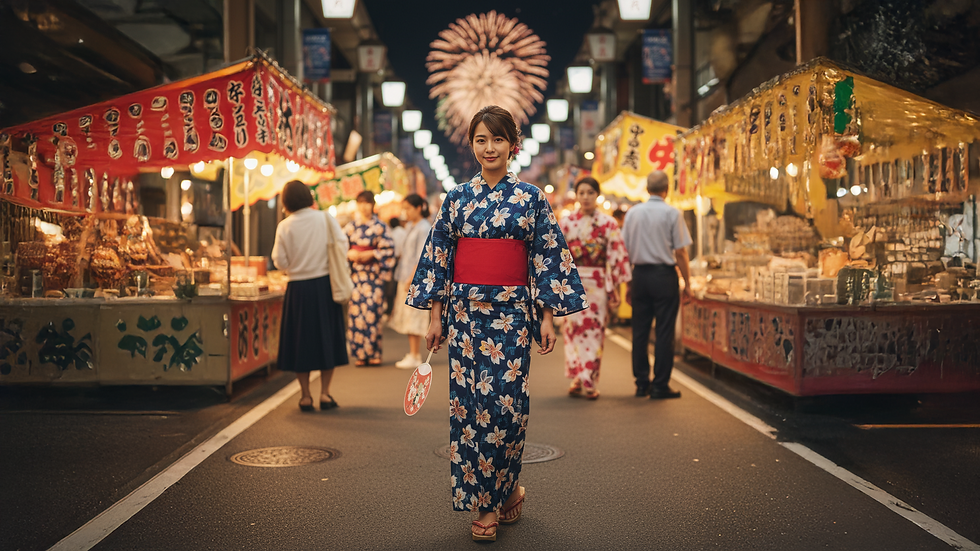日本文化的象徵:和服
- slwong9628
- Oct 4
- 5 min read
在眾多的日本文化中,最能代表傳統美學的就是和服 (Kimono / きもの)。它不僅是一件服裝,更是一種文化的象徵。從平安時代開始,和服就承載了日本人對四季、禮儀與美的追求。即使在現代,和服依然出現在婚禮、茶道、成人禮和節慶場合中。
和服的種類與特徵
留袖 (Tomesode / とめそで) 是已婚女性在正式場合的服裝,特徵是袖子短、顏色多為黑色,布料上繡有家紋,下半身有華麗的花紋。婚禮中新娘的母親或親屬常穿著。

振袖 (Furisode / ふりそで) 則是未婚女性的代表服裝,袖子很長,顏色鮮豔華麗,常見於成人禮和婚禮賓客。半正式場合適合 訪問着 (Hōmongi / ほうもんぎ),其花紋設計從肩膀一路延伸至下擺,給人典雅的感覺。

日常生活中,常見的是 小紋 (Komon / こもん),布料上有小而重複的花紋,顯得低調休閒。
在夏季,浴衣 (Yukata / 浴衣) 最為常見,棉或麻材質輕薄透氣,穿著簡單,適合花火大會與夏日祭典。
而 袴 (Hakama / はかま) 則像寬褲一樣,通常搭配和服,常見於畢業典禮、劍道、弓道等場合。



婚禮上,新娘會選擇 白無垢 (Shiromuku / しろむく) 或 色打掛 (Iro-uchikake / いろうちかけ)。白無垢全白純潔,象徵新的開始;色打掛則厚重大氣,繡有鶴、松、牡丹等吉祥圖案。
在日本皇室儀式中,還能看到古代貴族女性服裝 十二單 (Jūnihitoe / じゅうにひとえ),多層次的搭配華麗而莊嚴。



和服的配飾與特色
和服的美感,來自細緻的配件搭配。
最重要的配件是 帯 (Obi / おび),它是和服的靈魂。正式場合會使用厚重華麗的袋帯,休閒時則用輕便的半幅帯。

搭配和服的鞋子分為兩種:草履 (Zōri / ぞうり) 與 下駄 (Geta / げた)。草履通常與白色 足袋 (Tabi / たび) 一起穿,用於正式場合;下駄則是木製拖鞋,多搭配浴衣。



女性常會在髮髻上佩戴 簪 (Kanzashi / かんざし),舞妓與新娘特別常見。隨身小物則可放進 巾着 (Kinchaku / きんちゃく),是浴衣的標配。


此外,還有 帯揚げ (Obiageおびあげ) 與 帯締め (Obijime / おびじめ),分別用來固定和裝飾腰帶,使整體造型更完整。

和服在現代的角色
雖然現代日本人不再日常穿著和服,但它仍是 日本文化的象徵。觀光客到京都、淺草等地,常會租借和服拍照;在夏季花火大會,人們依然會穿浴衣;而在國際舞台上,和服作為 日本傳統服裝,展現日本的優雅與身份。
想快熟學習日文?點我預約免費試聽課!
Kimono: The Icon of Japanese Culture
Within Japanese culture, the most iconic symbol of tradition and elegance is the Kimono. More than just clothing, the Kimono reflects history, etiquette, and sensitivity to the seasons. Since the Heian period, it has been a central part of Japanese aesthetics, and even today, it is worn during weddings, tea ceremonies, coming-of-age events, and festivals.
Types of Kimono and Their Features
The Tomesode(留袖 とめそで) is a formal Kimono for married women, featuring short sleeves and often black fabric with family crests and elegant designs at the hem. It is commonly worn by mothers of the bride or groom at weddings.

The Furisode (振袖 ふりそで)is the formal attire for unmarried women, recognizable by its long, flowing sleeves and bright, colorful designs. It is typically worn at coming-of-age ceremonies.
For semi-formal events, women wear the Hōmongi(訪問着 ほうもんぎ), with continuous patterns running from shoulder to hem. For casual outings, the Komon(小紋 こもん) with its repeating small patterns is the choice.

In summer, the Yukata(浴衣 ゆかた), made of cotton or linen, is lightweight and simple, perfect for festivals and fireworks displays. The Hakama(袴 はかま), a pleated skirt-like garment, is worn by both men and women, often at graduation ceremonies or in martial arts like Kendo and Kyudo.



At weddings, brides wear either the pure white Shiromuku(白無垢 しろむく), symbolizing purity and new beginnings, or the luxurious, embroidered Iro-uchikake(色打掛 いろうちかけ), decorated with motifs such as cranes and peonies. For royal ceremonies, the elaborate Jūnihitoe(十二単 じゅうにひとえ), a multilayered garment from the Heian era, is still preserved.



Accessories of the Kimono
The Obi (belt 帯 おび) is the centerpiece, with formal Fukuro-obi for ceremonies and simpler Hanhaba-obi for casual wear.

Footwear includes Zōri(草履 ぞうり), worn with white Tabi (split-toe socks 足袋 たび) for formal occasions, and Geta(下駄 げた), wooden sandals often paired with Yukata.



Women also adorn their hairstyles with Kanzashi (hair ornaments 簪 かんざし), especially in bridal wear or Maiko style.


Small items are carried in Kinchaku (drawstring bags 巾着 きんちゃく), particularly when wearing Yukata. Other elements such as the Obiage (a sash scarf 帯揚げ おびあげ) and Obijime (a decorative cord 帯締め おびじめ) are used to secure and embellish the Obi, completing the outfit.

Kimono in Modern Japan
Though not worn daily, the Kimono remains an essential part of Japanese culture. Tourists in Kyoto or Asakusa often rent Kimonos to stroll historic streets, while summer festivals still see crowds in Yukata. Internationally, the Kimono stands as Japanese traditional clothing, symbolizing elegance and national identity.
The Kimono is not just clothing—it is a cultural legacy that represents Japan’s aesthetics and way of life. Through it, we can understand the Japanese sense of respect, harmony with nature, and pursuit of beauty. If you want to immerse yourself deeper in Japanese culture, learning the language is the perfect first step.
Want to know more about Japanese Culture?




Comments